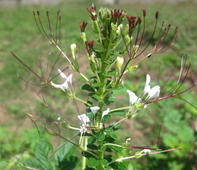
Eating Spider Plant
Throughout Africa, the tender shoots, leaves (and sometimes the flowers) of the spider plant (Cleome gynandra) are eaten; boiled as a stew, relish or side dish. The leaves are sometimes perceived as bitter and can be cooked in milk, added to other dishes or combined with other leafy vegetables such as cowpea leaves, black nightshade or amaranth.
In Zambia, crushed groundnuts (or peanut butter) are added for flavour. Leaves are also blanched, rolled in balls and then sun-dried and stored for up to two years, however, this greatly reduces nutritional quality. When dried leaves are needed, water is added to rehydrate it before cooking.
Boiling the leaves can reduce the vitamin C content by up to 81% and the vitamin A content by 95%. An edible seed oil is extracted by pressing spider plant seeds. The oil also contains a volatile oil, similar to mustard oil. This essential oil is also present in the leaves and is responsible for the odour and flavour of the vegetable. The remaining seed cake can be used for animal feed.
Whole seeds are fed to chickens and other birds. Cows, horses and wild game animals graze on wild-growing spider plants and the leaves can be fed to livestock as forage. Indigenous knowledge suggests that spider plant has medicinal values - a concoction of the leaves may treat scurvy.
In some cultures, eating spider plant leaves are said to increase energy and improve eyesight and is almost mandatory in the diet of pregnant women.
A decoction of the root is used to treat fevers, while the juice of the root can relieve scorpion stings. Crushed leaves are applied as a poultice on sore limbs (due to rheumatism) and boils. Juice from the leaves is said to treat earache, recurring malaria and epileptic fits.
Spider Plant as Plant Protector
As a plant protectant, it was noted that no ticks are found in the vicinity of spider plants while an ethanol extraction of spider plant material is toxic to pests such as the diamondback moth (cabbage moth) and the painted bug (Bagrada hilaris).
An extract of spider plant leaves repels aphids and thrips populations, while intercropping of spider plants with cabbage has been known to reduce diamondback moth and thrip attacks.
Similarly, French beans intercropped with spider plants are less affected by flower thrips. Spider plants are sometimes planted to reduce red spider mites in rose-growing greenhouses in Kenya.